Full company details
Edinburgh Instruments Ltd.
A Techcomp Instruments Europe Co.
 1 Bain Square
1 Bain Square
Kirkton Campus
Livingston EH54 7DQ
United Kingdom
Phone: +44 1506 425300
Fax: +44 1506 425320
Molecular Laser Opens Unique Spectral Window
Photonics.com
Jun 2021The deep penetrating properties of terahertz radiation make it appealing for use in industrial and scientific imaging, materials analysis, and biomedical research.Stuart Thomson, Edinburgh Instruments Ltd.

Courtesy of iStock.com/MickeyCZ
The terahertz spectral region, which falls between the microwave and infrared ranges, is one of the most promising regions of the electromagnetic spectrum for research and industry, but it is currently underutilized in these areas. There is no universal definition for what constitutes the terahertz band, but the frequency range of 0.1 to 10 THz (λ = 3 mm to 30 μm) is the most widely referenced (Figure 1). Due to its position within the electromagnetic spectrum, terahertz radiation has unique penetrating properties that make it highly attractive for spectroscopy and imaging applications across a wide variety of fields, including medical science, biology, security, astronomy, pharmaceuticals, materials science, and physics.
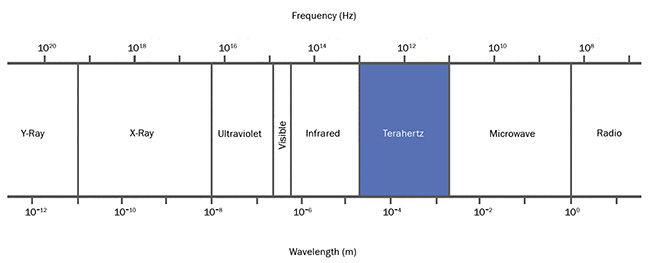
Figure 1. The terahertz band: 0.1 to 10 THz. Courtesy of Edinburgh Instruments.
Applications for terahertz radiation range from inducing quantum oscillations in semiconductors for fundamental physics research, to the nondestructive biomedical imaging of tissue using terahertz holography.
Terahertz sources
Terahertz spectroscopy and imaging applications require a source of terahertz radiation, with the exception of astronomy, where the astronomical object itself is the source. Terahertz sources can be split into two main types: ultrashort pulse and continuous wave. Ultrashort-pulse terahertz sources are the foundation of terahertz time-domain spectroscopy (THz-TDS), in which materials are probed with ultrashort pulses of terahertz radiation generated via femtosecond lasers. The ultrashort pulse results in a broad bandwidth of terahertz frequencies that enables fast acquisition times in THz-TDS, but with low-frequency resolution that limits its usefulness in spectroscopic applications. For applications that require high-frequency resolution, or terahertz excitation at a single, well-defined frequency, continuous-wave terahertz sources are required.
The diverse range of continuous-wave terahertz sources currently available commercially includes difference-frequency generation, backward-wave oscillators, microwave frequency multipliers, quantum cascade lasers, and optically pumped molecular lasers.
Backward-wave oscillators and frequency multipliers are extensions of microwave-type oscillator technology into the terahertz region. They can provide high power, but they become impractical at frequencies above 1 THz. Difference-frequency generation utilizes two IR lasers that are offset in frequency to produce terahertz radiation at the difference-frequency of the lasers, which results in a highly tunable terahertz source, but with low powers in the microwatt range. Quantum cascade lasers have long held promise as a terahertz source. They continue to advance but currently require deep cryogenic cooling for continuous-wave operation in the terahertz region, partly due to scattering at high temperatures. They are limited to powers in the low milliwatts and operation above 1 THz.
Each of these sources is ideal for many terahertz applications, but, in general, they either suffer from low power or limited frequency range. For applications that require high power at discrete frequencies across the terahertz range, the optically pumped terahertz molecular laser is the ideal source.
Terahertz molecular laser
The optically pumped terahertz molecular laser was first demonstrated in 1970 by Tao-Yuan Chang and Thomas J. Bridges at Bell Labs
1. It has since been optimized and refined for the delivery of high-power, coherent terahertz radiation over a wide range of frequencies. The laser is a workhorse of terahertz research laboratories around the world. It is known by several names in the scientific community, with the most common one being the optically pumped far-infrared (OPFIR) laser. It is also known as an optically pumped terahertz laser (OPTL), a terahertz gas laser, and a terahertz molecular laser.
In the optically pumped terahertz molecular laser, a pump laser is used to optically excite a vapor of polar molecules to a higher-lying energy level from which the molecules relax with the emission of terahertz radiation. The pump laser can take a variety of forms, with the most common arrangement being a CO
2 infrared laser, the output of which is coupled into the terahertz molecular laser. This coupling can be either external, such as on an optical table, where the pump laser and terahertz laser are separate entities, or internal, where the pump and terahertz lasers are contained within a single unit.
The main components and the operating principle of the laser are shown in Figure 2. The schematic is based on an Edinburgh Instruments far-infrared laser (FIRL)-100, where the CO
2 pump and the terahertz molecular laser are integrated into a single system capable of outputting both infrared radiation (9 to 11 μm, or 27 to 33 THz) and terahertz radiation (40 μm to 1.22 mm, or 0.25 to 7 THz).
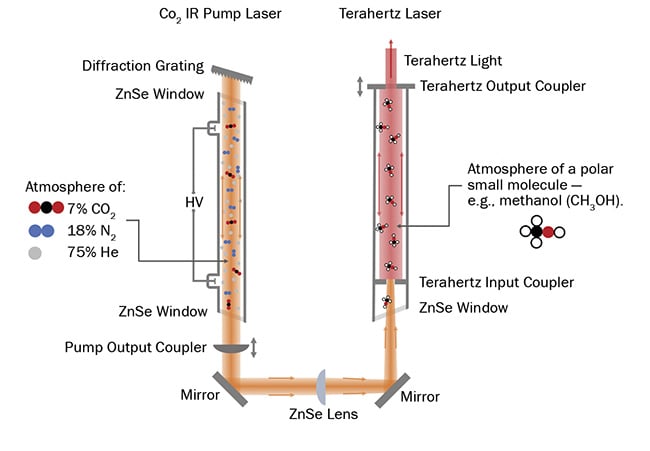
Figure 2. A schematic of an optically pumped terahertz molecular laser system. HV: high voltage. Courtesy of Edinburgh Instruments.
Stage 1: CO2 IR pump laser
The process starts with the CO
2 pump laser, which consists of an optical resonator formed between a diffraction grating and a partially reflecting zinc selenide (ZnSe) output coupling mirror. The ZnSe mirror is mounted on a piezoelectric transducer to allow for fine control of the resonator length. The gain stage is a high-voltage gas discharge tube — sealed with Brewster angle ZnSe windows — that sits between the grating and the mirror.
To achieve lasing, a carbon dioxide/
nitrogen/helium (CO
2/N
2/He) gas mixture is flowed through the discharge tube, and the N
2 molecules are promoted to a vibrationally excited state via collisions with electrons from the electric discharge. The N
2 excited state is close in energy to the 0001 vibrational excited state of the CO
2 molecule, and population of the 0001 state proceeds through resonant energy transfer. A population inversion now exists between the 0001 and the lower-lying 0200 and 1000 vibrational states of CO
2, facilitating stimulated emission and lasing to occur between them (Figure 3).
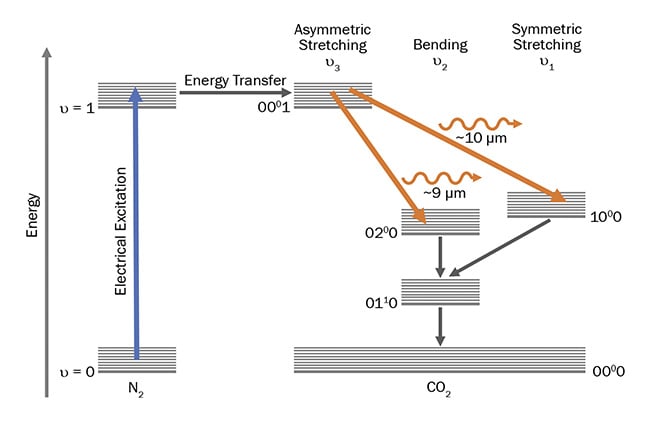
Figure 3. A simplified energy-level diagram of the CO2 lasing mechanism. ν: vibrational state. Courtesy of Edinburgh Instruments.
The vibrational transitions are grouped into two bands, the 10- and 9-μm bands, and within each band are a manifold of possible vibro-rotational lasing transitions with various emission wavelengths. By changing the angle of the diffraction grating (making a coarse adjustment) and the length of the optical resonator through the piezo mirror (fine-tuning), the desired transition can be brought into resonance — with ~80 laser transitions selectable between 9 and 11 µm (27 to 33 THz).
Stage 2: terahertz molecular laser
To generate terahertz radiation, the output from the pump laser is focused down and coupled into a sealed terahertz resonator. This setup comprises a ZnSe input Brewster window that forms a vacuum seal at one end of the resonator, an input coupling mirror, and a dichroic output coupler that enables extraction of the terahertz emission while reflecting the IR pump beam. The resonator is evacuated and filled with a low-pressure vapor of a small molecule possessing a permanent dipole moment — meaning that two or more atoms within the molecule have very different electronegativities. Optical pumping by the CO
2 pump laser excites the molecules to a vibrational excited state (Figure 4), creating a population inversion between the rotational states, J, within the vibrational excited state, which can undergo stimulated emission and lasing. The transitions between the rotational states are much lower in energy than the vibrational transitions involved in the CO
2 laser, falling within the 0.2- to 8-THz range. The output frequency of the pump laser is tuned to excite the desired vibro-rotational transition of the molecule. And the terahertz resonator length is tuned to select the rotational transition that is in resonance and, therefore, the output frequency of the laser.
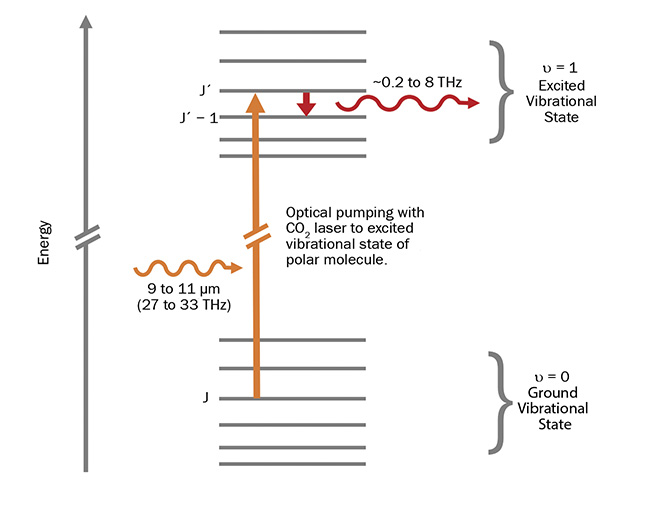
Figure 4. A simplified energy-level diagram of the terahertz molecular laser. J: rotational state. Courtesy of Edinburgh Instruments.
Choice of molecule
A wide range of laser-active molecules can be used to generate the terahertz emission. In general, the molecules should possess a permanent dipole moment, be able to form a vapor, and have vibrational transitions that can absorb the pump laser frequencies. These requirements are satisfied by using lightweight polyatomic molecules such as fluoromethane (CH
3F), difluoromethane (CH
2F
2), and methanol (CH
3OH). Over 1000 laser lines have been identified across the 0.2- to 8-THz frequency range
2,3. The 2.52-THz transition from CH
3OH vapor is particularly common within terahertz spectroscopy and imaging research, with output powers >100 mW readily achievable using this transition.
Terahertz imaging
The terahertz molecular laser excels at applications that take advantage of its high power, stability, well-defined frequency, and long coherence lengths. One such application area that is of great interest for both academic research and industrial testing is continuous-wave terahertz imaging. Because terahertz radiation lies at the boundary of the microwave and infrared regions of the electromagnetic spectrum, it shares characteristics with both that make it attractive for imaging. Similarly to infrared radiation, terahertz radiation can initiate energy transitions within materials and be used to spectroscopically identify various materials and chemicals through their unique spectral fingerprint. And like microwaves, terahertz radiation can penetrate many nonconducting materials — such as plastic, clothing, masonry, and semiconductors — enabling nondestructive imaging through these materials, but with a superior spatial resolution due to its shorter wavelength.
These penetrating properties make terahertz imaging attractive for materials analysis, industrial nondestructive testing, and security screening. Terahertz will pass through fabric and plastics but be strongly absorbed by metals, creating contrast in the image. It is equally appealing for biomedical applications, because it can penetrate farther into tissue than visible and infrared. It is also nonionizing, possessing an energy ~1 million times lower than typical imaging x-rays. Therefore, it poses little risk to health and is unlikely to cause photodamage in biological samples during imaging.
At present, the most established terahertz imaging methodology is an extension of the THz-TDS technique, in which the sample is raster scanned through the pulsed excitation spot to build up a two-dimensional image pixel by pixel. This approach provides a wealth of information but suffers from long acquisition times due to the step-wise method of image creation. A wide variety of alternative imaging techniques are therefore being actively researched to utilize continuous-wave terahertz sources, one of which is continuous-wave terahertz digital holography.
In continuous-wave terahertz holography, the interference pattern between a terahertz wavefront scattered by an object (the object beam) and a coherent wavefront that has not interacted with the object (the reference beam) is recorded using an array detector
4 (Figure 5). The amplitude and phase information are encoded in the hologram, enabling amplitude and phase-shift images of the object to be numerically reconstructed, which reveals information on the internal structure. Since the image formation process relies on coherence between the object and reference beams, a source with a long coherence length, such as an optically pumped molecular laser, is required.
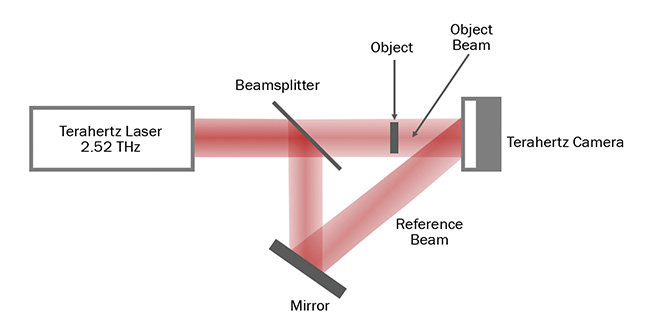
Figure 5. An off-axis digital holographic imaging setup using the 2.52-THz line of methanol. Courtesy of Edinburgh Instruments.
A video-rate terahertz holographic imaging system that used a terahertz molecular laser as the source was recently demonstrated in a laboratory setting
5. Using the system, the researchers were able to image a metallic object concealed within a paper envelope and a polyethylene bag, highlighting the potential of terahertz holography for real-time remote sensing in industrial quality control and security screening. The utility of digital holography for various biomedical imaging applications is also under intense research
6,7. The technique is capable of distinguishing between cancerous and healthy tissue, and it could be used by surgeons to identify tumor boundaries prior to surgical resectioning of cancerous tissue
6,7.
Terahertz spectroscopy and imaging technology have advanced significantly over the past decade. Continued improvements in the performance and availability of terahertz sources, detectors, and signal processing will open up increasing fundamental and industrial applications to the power of this unique region of the electromagnetic spectrum.
Meet the author
Stuart Thomson, Ph.D., is the applications manager at Edinburgh Instruments Ltd.
He received a doctorate in semiconductor
optoelectronics from the University of
St. Andrews and specializes in the spectroscopy of semiconductor materials; email:
[email protected].
References
1. T.Y. Chang and T.J. Bridges (1970). Laser action at 452, 496 and 541 μm in optically pumped CH
3F. Opt Comm, Vol. 1,
pp. 423-426.
2. E. Bründermann et al. (2012).
Springer Series in Optical Science: Terahertz Techniques. Springer-Verlag.
3. N.G. Douglas (1989).
Springer Series in Optical Science: Millimetre and Submillimetre Wavelength Lasers. Springer-Verlag.
4. Y. Zhao et al. (2019). Iterative phase-retrieval-assisted off-axis terahertz digital holography.
Appl Opt, Vol. 58, pp. 9208-9216.
5. M. Humphreys et al. (2018). Video-rate terahertz digital holographic imaging system.
Opt Express, Vol. 26, pp. 25805-25813.
6. M. Wan et al. (2020). Terahertz phase imaging and biomedical applications.
Opt Laser Technol, Vol. 122, Article No. 105859.
7. Y. Zhang et al. (2021). Continuous-wave THz imaging for biomedical samples.
Appl Sci, Vol. 11, Issue 1, p. 71.